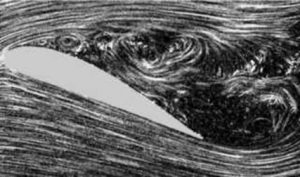The stall of controlled airliners
PDF
Let’s see what it’s all about first. Since lift is the result of pressure forces on the wing contour, for it to be positive, it is necessary that the air velocity on the upper surface (above the wing) is greater – the pressure lower – than that on the lower surface (below the wing). However, the opposite happens in the event of a well marked separation, since the vortex clearly visible in Figure 1 brings air back to the immediate vicinity of the wall and thus reduces the relative velocity between the wing and the surrounding fluid. This phenomenon, which is not violent but progressive, is linked both to a slowdown of the aircraft, which is already sufficient to explain a reduction in lift, and to an excessively rapid increase in incidence, often controlled by the pilot to compensate for the decrease in speed. The critical value of the incidence leading to the stall depends on the speed and shape of the wing. In general, it is between 5° and 20° °; it is close to 16° in the particular case of Figure 2. Moreover, since this stall is related to the disbonding of the boundary layer, as soon as it appears, the eddies present in the area of the wall that is lifted off generate fairly large pressure fluctuations that shake the aircraft and thus warn the pilot.

So how do we react? Prior to 2009, the procedure by which all pilots were trained was to increase engine power to regain speed, while decreasing incidence and allowing the aircraft to descend. To follow this procedure, the pilot needed accurate information on the flight parameters. In the case of the Rio-Paris flight, the black boxes revealed that the pilots had been deceived by the aircraft. The external Pitot probes used as speed sensors had frozen and indicated an overspeed that caused the pilots to brake rather than accelerate; the on-board computer also gave the order to pitch the aircraft up instead of reducing its impact.
Since this unfortunate accident, the manufacturers have upgraded the pilots’ information systems, giving them the opportunity to take control of the on-board computer in the event of inconsistent information from the various sensors. For example, Airbus aircraft are now equipped with two separate systems: one that gives the aircraft’s speed based on data provided by the usual sensors – still Pitot probes – and another that derives it from the incidence probes. Pilots and airlines agree that the risk of stalling is controlled.




